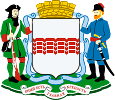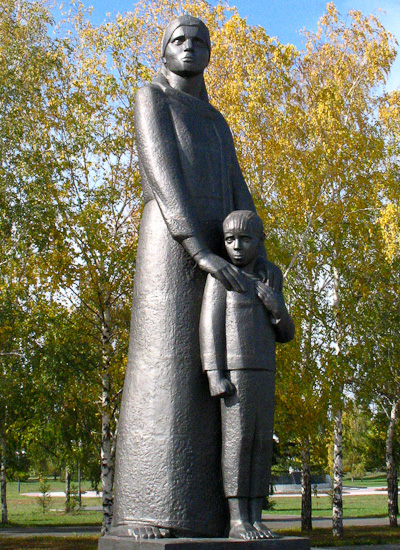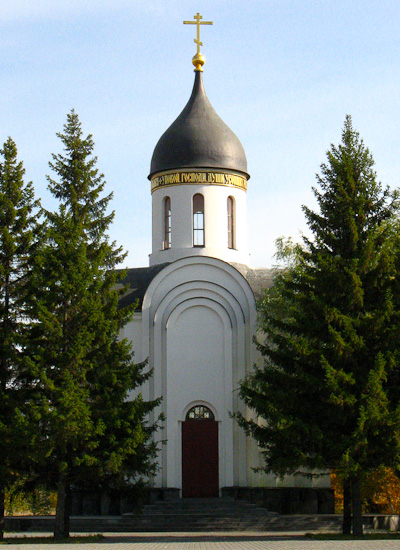Parks and Public Gardens
When crossing the Irtysh River over to the left bank, one can see one of the most beautiful parks of our city named after the 30th anniversary of the Victory. In 1975 the Victory Memorial was inaugurated in the park. This complex begins at the bus-stop next to the road. An underground passage, wide stairs and path will take you to the central square. From this square one can easily reach the compositional center of the complex, where you find the 14 meter tall sculpture of Soldier-Victor.
©Photo courtesy of Municipal government history museum
Park named after 30th anniversary of the Victory. Soldier-Victor.
A symbolic Road of the War — a 230 m long cobblestone pavement — serves as a linking element of the memorial complex. It starts out at the 9 meter tall statue of Siberian Mother with Her Son. The sorrowful bowed Siberian woman stands at the beginning of the long Road of the war expressing of 1418 days of hard, exhausting work and the same number of nights spent with tears in her eyes, longing and waiting. The woman’s face symbolizes a total dedication and fixed determination of the compatriots to overcome all the difficulties and to pave the way for the victory. The figure of the boy is also symbolic: it depicts a teenager of the war period, representing the generation that fought for the victory together with the adults and after the war rebuilt the devastated country. Birches behind the statue symbolize our home region — Omsk Priirtysh’e ( Omsk Irtysh River region).
©Photo courtesy of Municipal government history museum
Siberian Mother with Her Son
Along the stone path there are 18 granite monuments, each 1.5–3.5 meters high. Five monuments bear the dates of the war, 13 monuments are furnished with reliefs of some episodes of the Great Patriotic War featuring voluntary enrollment, taking the oath and the Victory parade (the reliefs were created upon the design of the painter V. Tsimmerman). At the monuments’ foot underneath the stones made of black labradorite there are artillery shot shells immured together with soil from the battle fields of the Omsk unites. A straight line of fir trees has been planted behind the granite monuments along the memorial. The memorial is being capped off by a gigantic sculpture of Soldier-Victor with a groundsheet on his shoulders and a bay leaf garland on his head, raising a sword over his head. This clearly represents an impressive symbol of the great victory.
In Victory Park one can also find a chapel built in 1996 in memory of the soldiers who died in the war. The chapel has been consecrated in the name of the three saint warriors of Rus’ — Saint George the Victorious, Alexander Nevsky and Dmitry Donskoy (Dmitry of the Don). Architects G. Tchirkin, Y. Bardytchev, A. Mitchurov and sculptor V. Trokhimchuk succeeded in perfectly fitting a classical light building in old Russian style to the architectural landscape of the park and the memorial complex.
©Photo courtesy of Municipal government history museum
Chapel in the Victory Park
Omsk Victory Memorial is one of the largest monuments in the Eastern part of our country. It has become a landmark of Omsk city. This war always remains unforgotten. Old and young people visit it in order to pay homage to the memory of those who died on the battle field, to pay respect to those who died in combat fighting our enemies, thus saving our homeland.
©Photo by Vladimir Safonov
The war always remains unforgotten
In Recreation and Entertainment Park named after the 30th anniversary of the All-Union Leninist Young Communist League a monument to Omsk war workers was opened in commemoration of the 65th anniversary of the Great Victory. It’s a large-scale sculpture devoted to the workers of the homefront in Russia. This monument is 8 meters tall, 13 meters long, and weighs some 80 tons. Project designers are Sergey Noryshev and Igor Vakhitov. This massive monument has been made of concrete and copper. It’s a nine-figure statue group symbolizing Omsk war workers: a mother who had seen her sons off to the front; a woman with a baby in her hands; a countrywoman going to the haying; a worker at an arms industry plant; finally, a nurse.
©Photo by Vladimir Safonov
Monument to war workers
Park’s landscape is typical for the south region of Western Siberia. Park is full of foliage and evergreen trees, lakes, flowers and green lawns. Citizens enjoy walking nice lanes, benching in the shadow. Omsk musicians and dancers appear on the stage in the center of the park on Saturdays and Sundays: while they sing modern and folk songs, children take the floor near the stage. On Summer park attracts local artists who draw portraits of people walking about.
©Photo by Dmitry Roudakov
Winter walk
The area of Omsk city is furnished with numerous fountains. The most beautiful of them are the three fountains made of cast iron in classical style: the first one is located in Tarskaja Street, the second one is situated in the park named after the 30th anniversary of All-Union Leninist Young Communist League, and the last one is set up in front of the Administration of the city of Omsk.
©Photo by Vladimir Safonov
Fountain next to the Administration of the city of Omsk







